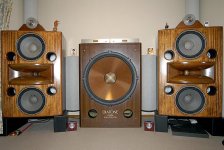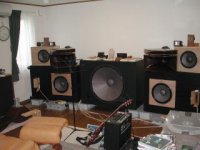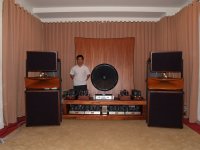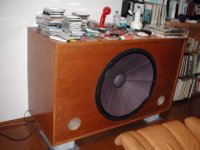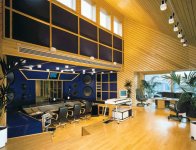The only woofers I've heard that really keep up with good midrange horns is the Onken W with Altec 15s. No other direct radiator I've heard comes close. I didn't actaully know how inept most woofers are, until I heard that big box (with the right amp). It's one of those things that makes you shake your head and say "Speakers can't DO that!"
The first time I heard Don Keele's CBT arrays it was obvious that the woofer he was using could not keep up with the array. It seemed flabby and boomy to me. Like a speaker. No one else I asked had any problem with it. I hear a lot of speakers that sound like very good speakers, but they still sound like speakers. Maybe that's what most folks expect.
I hear a lot of speakers that sound like very good speakers, but they still sound like speakers. Maybe that's what most folks expect.
Yes, Frank - subs can have a "style". Most sound just like subs. The rare good ones sound like natural sounds, no speakers. I think the servo subs would make a lot of people very happy, based on the big grins and "Wow!" comments that go around the room when they are demo'd. They are certainly a large step in the right direction, but still not really the sound I'm looking for.
The first time I heard Don Keele's CBT arrays it was obvious that the woofer he was using could not keep up with the array. It seemed flabby and boomy to me. Like a speaker. No one else I asked had any problem with it.
 I hear a lot of speakers that sound like very good speakers, but they still sound like speakers. Maybe that's what most folks expect.
I hear a lot of speakers that sound like very good speakers, but they still sound like speakers. Maybe that's what most folks expect.Yes, Frank - subs can have a "style". Most sound just like subs. The rare good ones sound like natural sounds, no speakers. I think the servo subs would make a lot of people very happy, based on the big grins and "Wow!" comments that go around the room when they are demo'd. They are certainly a large step in the right direction, but still not really the sound I'm looking for.
I think there is too much compromise in that kind of design.agreed. But 39.75" total length for a 100hz horn is no worse than placing a pair of open baffle speakers 3' from the back wall. See:
DIY 100hz midbass horn - The Paper Horn by Inlow Sound
I love cute answers ...The same as I'd want above 100 Hz, I suppose.
The biggest challenge with any conventional vented box is the excess-excursion problem below Fb; unless this is controlled, the woofer VC will be wandering in and out of the linear area of the gap. Underhung VCs, although great for low-mid/upper-bass applications, are going to have real trouble with uncontrolled LF excursion. Overhung VCs, particularly modern ultralong excursion designs, will do a lot better, but you're still wasting valuable system headroom on LF excursions that don't even produce sound (since it falls below the system passband).
Hello Lynn
I am surprised to read this are many on this forum having this problem with reflex boxes?? Most would be using CD's with vinyl I can certainly see a possible source where you could potentially get large amounts LF input below FB.
The easy answer is to simply use a 20 or 25Hz high pass filter. Most plate amps come with an adjustable one that you can tailor around the FB of the box.
I use a double 15 low end in my active set-up similar to what you seem to be considering. I use an under-hung 15" woofer from 90Hz to 300Hz and below 90Hz I use overhung woofers with an FB of 26Hz. I use a 6 db boost at 26Hz and the roll-off from the filter helps protect the woofer below 20Hz.
There is a group delay penalty to pay at FB but @ 26Hz I am not to concerned about audibility. I think the split bandwidth between the woofers is the way to go. You have a lot more control that way. You can even shift placement a bit and depending on spacing you can get some mutual coupling going on and get a real 6db gain in the last octaves. Every little bit helps.
Rob
They did impress me, and others who heard them. I thought in the genre, they are very good. But the style isn't exactly my taste. I've never thought them synthetic, but others have mentioned that. To me, they were what I imagine most subwoofer fans want. Strong, powerful, controlled - maybe a bit artificial, so they are kind of "powerful speaker" sounding - but how do you judge a subwoofer in isolation?
The rare good ones sound like natural sounds, no speakers. I think the servo subs would make a lot of people very happy, based on the big grins and "Wow!" comments that go around the room when they are demo'd. They are certainly a large step in the right direction, but still not really the sound I'm looking for.
Hi Pano
I wonder if they were not just being played too loud instead of being properly integrated. Playing them too loud is a sure way to impress, but it wrong. As you said, one should not really be able to hear a good sub, just notice the effect it has by how the music 'expands' more, for lack of a better description. Music just sounds more natural, as you said. Do you think that might have been what put you off (the subs set too loud)? It is an easy trap to fall into, but the Rythmik Audio subs are very adjustable and if done right, should blend well.
They are a great sounding subwoofer, but I don't believe they are what Lynn is looking for. Perhaps too much Sturm und Drang for the style he seeks.
This line really made me smile. I am a bass nut, so this is what I like.
Deon
Mr. POOH, I was speaking to IslandPink's experiences, not yours. Nothing personal, but I haven't heard your setup, and have no idea if we have the musical tastes or not. So I have no idea if your subjective experience is the same as mine.
By comparison, as mentioned above, IslandPink has actually built amplifiers and loudspeakers following my designs. In private conversations, he usually comes up with interesting variations that take the designs off in entirely new directions, and give me new ideas as well. If IslandPink says XYZ driver in ABC sounds like thus-and-such, I have a pretty good idea what's he's talking about.
Mr. POOH, I get it. You're an all-horn guy. Understood. But I'm getting tired of your moral judgements. This is an audio forum, not a church, and we're all free to discuss what amount to subjective musical preferences.
What crystallised a few years ago was the offshoots of many different but related groups/niches you have mentioned before, and is really great that this has happened. It has given the opportunity for those with a strong interest to develop their own particular niche. We know that no one niche can achieve all things to all men.
So verybody seems to want something different with directs, horns, amps, sound quality authenticity, loudness or great low level sound and so on.
Each niche wants the best to suit its criteria. Ariel is a niche as you have described it for DHT or valves down to 1 watt as the aim. not the result just the aim. Change that if I have missed the target.
As Ariel in all its variants does lot more.
The adoption of a horn system during the thread ,did not start I believe as definitively as horn system, but quickly moved to that.
With this thread and else where ther seems to be crystallisation on the 2 x huge bass reflex direct drivers with the mid treble AH425 and possible RAAL or similar. This idea seems to be of interest in Germany judging by the magazines there.
Now that combination is a niche, no problem, excludes the built into wall LF horns, unfolded horn, free standing folded horn (acceptible).
This powerful combination, is it really for 1 watt DHT amps with their exquisite low level reproduction, and yet enough power with a HES horn to be the project speaker. It has in my view, possibly drifted up to where you do need to use a real power amp, rather than a virtual high output very low impedance preamp as a power amp for HES.
I know the quality of the 1 watt triode amp DHT or IHT cannot really be outclassed for purity and quality (broad term), but which is the paramount purpose? 1 watt DHT plus super powerful HES full hornspeaker or horn hybrid. Or say 20 watts DHT/IHT triode amps with still quite powerful HES horn system/bass reflex or similar. The latter is more flexible probably like Ariel.
Or should it extend to a multiamp multi speaker complexity with the 1 watt DHT on the RAAL or CD treble horn, 10 watt DHT transformer coupled mid/treble CD and twin bass reflex on a powerful class AB (class D if you must).
And can you again clarify whether the AZ425 and 745 with or without RAAL can reproduce exceptionally good low level sound 50dB to 60 dB like Quad ELS but with microdynamics with say 120dB dynamic range. I think only top directs including RAAL Aurum Cantus etc can do that.
We all often end up with more than one system at any one time. So this also makes a difference to one final choice. Ariel was clearly never PA but if you can get purity and subtlety low to high and do PA as well as domestic that is a wider different goal so maybe the goal has changed. And that is ok if it has.
…
My experience has been that drivers have distinct "personalities", and that equalization does not make them sound alike ... going further, that excess equalization is a sign of trouble with the driver, and should be avoided if possible. Conversely, if a driver sounds exceptionally good/realistic/musical, there are almost certainly good physical reasons it sounds that way.
This makes much sense to me.
…
Nothing personal, but I haven't heard your setup, and have no idea if we have the musical tastes or not. So I have no idea if your subjective experience is the same as mine.
…
Quite often, some people overlook the fact that different people have different musical taste – and as a result of this – different people will have different subjective impression from the very same audio system.
It seems that in order to bypass the subjective impressions differences issue, some people resort to measurements only, disregarding any subjective impressions – both their own and others'.
When sound has a style or sonic signature, that = distortion. So, do you want some sort, quality, of distortion, or for the distortion to be inaudible?
There isn't even a single component in the sound recording -> reproduction chain that is free from any distortion (when distortion here means deviation between the originating sound waves and the reproduced ones).
Now, a possible valid question may be what kinds of distortion can be eliminated and what cannot be eliminated. Alternately, what kinds of distortion are easier to eliminate, or to attenuate – hence, where is the best to focus on.
Another possible valid question may be what kinds of distortion have greater impact than others on the perceived sound quality – hence, where is the best to focus on.
Deon. Yes, quite possible. For a lot of complex reasons most woofers and subs sound like woofers to me. They sound like speakers, not real. Getting them to sound real must be very, very difficult or we would hear more good ones. Once you've heard it - you'll be spoiled. 
Of course I do understand other tastes in bass. What is sometimes called "Effects Bass". As you say, not real. But a hell of a lot of fun.
Of course I do understand other tastes in bass. What is sometimes called "Effects Bass". As you say, not real. But a hell of a lot of fun.

..... I surmise this is what's going on with the Onken setup.
...... the group-delay implications of passive radiators that bother me a little, although the group-delay peaking is at a very low frequency. ..
Your experience with the 8" Fane in a big Tractrix is most interesting. I was wondering what would happen if a horn with the usual time-domain issues was mated with the very fast-decaying AH425; if I understand right, it exposes the horn that has more reflections.
Would the 414 or Tone Tubby be better? I think there would be a loss of dynamics, at least in the critical 200~400 Hz range, which is more or less the center of the orchestral spectrum, and a region where real power and headroom is needed.
Hi Lynn
Some good points to discuss . Let me see....
Well, the things I noticed about the Onken were :
A lot less tonal colour than the Supravox driver could deliver on OB .
Overhang ( reverb in the box I think ) when playing eg mid piano notes ( without sustain ) that stopped cleanly on the 288/Azura but were still decaying for a good fraction of a second in the Onken ! This was after a fair bit of effort in bracing , although I could have gone further .
Group delay - I have been gently brow-beaten in the past by James about the low group-delay of drivers used on OB , but I'm no expert ! Maybe this breaks down at the low-end, but it doesn't seem that way .....
The Tractrix horn results were perplexing, but some background might help - I listen in a largish 'European' room, about 23ft x 15ft x 9ft ; not a 'barn-sized' US or Australian room . I also don't do much listening above about 80dB average level, measured at ~3m distance from the speakers .
The Tractrix horns, with either B&C 8PE21 or Fane St.8M 8-ohm, were plenty dynamic enough if turned up, but not very dynamic or subtle at low levels . This was in contrast to the drivers alone, listened to 'naked' on the floor ( the drivers, not me ) , which had lots of delicate microdynamics and tone - the B&C though being better in this respect.
Incidentally I marginally preferred the Horn with the B&C's - in contrast to John Hasquin's experiences .
My interpretation of this overall was that the very low excursion levels of the drivers when used on the horns meant they were not really getting into their proper 'window of operation' .
I was also hoping the use of the correct back-volume would help the sound to come right, as suggested by Romy & John, but I could not reproduce the results others found - this was the most frustrating aspect of the work I did with the horns, and I don't know if I missed something there in what I did .
I wasn't entirely happy with the basic tone on the wooden horns either - maybe the assumptions about a plane-wave starting at the throat are not close enough with a cone driver and 4" ( effective ) throat ? They were built in the rectangular format, with two flat sides and two curved sides, although Bruce's designs get very good press ( eg. from my friend Paul who still talks about the 'Titans' 10 years after hearing them at VSAC ) . There is some debate about tractrix vs. exponential in that band - Bruce comes down in favour of exponential .
I take your point about 15" drivers and power in the 200-400Hz region , if you want to reproduce the orchestra's power . Although I have a wide range of music ( LP ) I do tend to centre on the Folk-rock, psychedelic and singer-songwriter genres from 1965-1975 a fair bit . My system HAS to reproduce guitars as well as possible ! - I can trade sledgehammer dynamics in the bass . I'll have to see how the transition to tapped-horn or sealed-box sub below 100Hz works out, and if it helps boost the perception of dynamics down there.
Yes, the 515's and the 414 are not ideal for OB - James tells me about 0.7 to 0.8 Qts is about right . It would be nice to hear them, though - I heard Altec 515's , but not the 414's . Tone Tubby has limited excursion, but ought to be good enough for my needs - and they won't break the bank, for an experiment. I'm looking at crossing them 1st-order low-pass, but also use a 'soft' notch filter centred around 3kHz , to knock about 6-8dB off the 'guitar-speaker-peak' .
I'm using a bi-amp set-up of course.
Ok, must dash ( & eat ! ) .
MJ
Deon. Yes, quite possible. For a lot of complex reasons most woofers and subs sound like woofers to me. They sound like speakers, not real. Getting them to sound real must be very, very difficult or we would hear more good ones. Once you've heard it - you'll be spoiled.
Hi Pano
May I suggest a possible reason for this. I think that most subs are over-stressed. We think because they are big and can go low, they should sound effortless and real. I don't think so. Some may laugh at my suggestion for six 12" woofers per side, but I believe that is what is needed to make the low bass seem real. These subs are asked to go down to the low 20Hz range, and still do the rest well. There is a lot more information low down than we realize. I read of one forum member that uses two subwoofers, each consisting of four 15" woofers in a 800-liter reflex box, one per side. He said himself that that is what it took to get the bass real and effortless. He said that most normal subs are over-stressed. Now that is my kind of idea for a real effortless sub. One you won't 'hear' because it is not straining at almost any volume. I remember once reading about someone who heard a pair of electrostatic subwoofers. He said they were huge (think along the lines of 8ft tall by 6ft wide). The thing is, they reproduced the bass better than anything else he had ever heard, before or since. They were totally effortless and transparent. StigErik's system is another example of this- eight 21" woofers per side (stacked in four towers, each four units high, set either side of his B&G RD75 ribbons). That is sixteen 21" woofers in one room! But that is what is needed for bass to become effortless. OK true, StigErik's system is an OB which has it's own problems with getting low bass, but nevertheless. If people think this is ridiculous, just take a look at the mid-range part of the LTO- a 2" compression driver on a horn that together could do probably well over 120dB at full tilt, even though we would never even come close to those levels in our own homes. Add to that the fact that the cross-over point never come even moderately close to it's full bandwidth extremes. What it does is lend a huge amount of headroom, and effortlessness. The drivers are never even close to straining, so they sound natural, at ease. Really good bass is not cheap! Three pairs of 12" MF subs per side will not be cheap, but they won't sound like your typical sub. They will disappear and just leave the music. Well, IMHO anyway. YMMV. I wonder how many people on this forum has heard a really huge, well set-up subwoofer (and I am not taking about horns here). I think it might be an eye-opening experience. Just a thought. And no, I have not either, but I have been around long enough and read enough to believe this to be true. Again, as always, IMHO and YMMV.
Deon
Last edited:
I think Deon has a point. One of the more convincing sub set ups I have heard was twin towers of 6 12" peerless drivers in an open frame (no baffle to speak of). That set up did seem effortless and authentic. I think with low bass it's the old adage "no replacement for displacement". I don't recall the amps used. The subs were crossed low enough that all the focus was on the main stereo pair with no sense of the low end coming from the towers just a real sense of low energy in the room consistent with the music.
One design aspect that should be kept in mind when contemplating the use of large line array subs with point source mids and highs is that the spl will drop off at a different rate with distance, depending on the frequency, so the system can be voiced only for one particular listening distance.
Hi Pano
May I suggest a possible reason for this. I think that most subs are over-stressed.
[...]
Deon
I agree. To put it simply, the lower the excursion required to produce a given SPL, the better (i.e. more 'natural') the sound.
That's why 80cm woofers like the Fostex FW800 / -N / -HS and the Diatone D-80M exist(ed), and why some Japanese audiophile use them. Yes, they are relatively Xmax-limited, and yes, you can produce the same SPL at 20-40Hz with a single high-excursion, high Mms 12" subwoofer. But NO, it will not sound the same.
Marco.
[Edit] P.S. The last picture is of the control room of a recording studio employing 2 Fostex FW800N per channel.
Attachments
Last edited:
- Home
- Loudspeakers
- Multi-Way
- Beyond the Ariel
